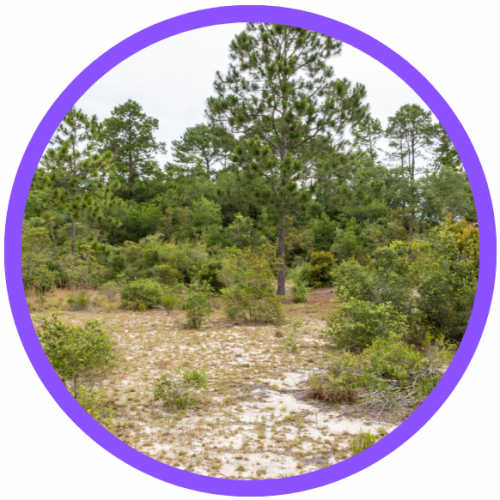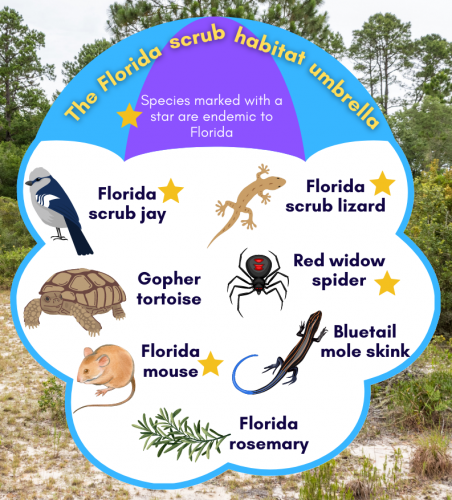Did you know there’s a bird in Florida that ONLY lives in Florida?
The Florida scrub jay is a beautiful blue and silver bird that inhabits the unique scrub habitat of Florida’s ancient dunes— and is found nowhere else in the world. Read on to learn more about the lifestyle of this endangered bird, how it is important for the ecosystem, and what you can do to help it flourish.
What’s going on?
The Florida scrub jay is the only bird species endemic to Florida, meaning it is found nowhere else in the entire world! Unfortunately, the Florida scrub jay is also endangered, with fewer than 10,000 individuals remaining.
A Unique Home
Florida scrub jays are dependent on scrub ecosystems, consisting of low-lying myrtle, Chapman’s oak, and shrubs with interspersed sandy openings. Scrublands are found on ancient sand dunes and ridges along coastal and central Florida where the sea once receded.
This sandy, dry, dotted landscape breathes life into the Florida scrub jays. Not only does the low foliage, seldom higher than 7 feet tall, prevent the onset of predatory birds, but the sandy patches allow the jays to cache thousands of acorns for winter food each year. The jays can even remember where each acorn is hidden, and check on their stores regularly to see if the acorns are rotting!
The Human Factor
But destruction of the jays’ unique habitat has led to their decline. As people have sought out the high, dry lands that are indicative of scrub habitats, citrus agriculture and housing development has shattered the scrub into remnants of its former self.
Small, scattered patches of scrub are difficult to manage correctly, as the proximity to neighborhoods and other developments makes prescribed fire an improbable solution. When regular fire is excluded, scrublands can mature into thick oak forests, filling in the sandy spots where jays store their food, and inviting predatory birds into jay territory. The fragmentation of scrublands also makes it difficult for jays to relocate, and leads to a lack of genetic diversity within populations.
Family First!
Florida scrub jays are social and charismatic birds, and engage in a rare family structure called “cooperative breeding.” This means a family of jays will consist of a breeding pair accompanied by up to 6 “helpers,” who are often older offspring. Helpers act as sentinels to watch for danger, as well as help feed and raise scrub jay babies. Each family group occupies a territory of about 25 acres of scrubland. Scrub jays are homebodies and will rarely relocate their territory, or even venture more than a mile in their lifetime!
This sedentary quality is what makes habitat fragmentation and improper land management so dangerous for the scrub jays. If their territory is traversed by roads and buildings, or if the scrub grows high and dense enough to allow predators to convene, then the scrub jays are unlikely to survive.
Why it matters 
The Florida scrub jay is an important umbrella species— or indicator species– for the endangered scrub habitat. This means that the health of their populations is an indication of how healthy the scrub habitat is for other species that also rely on it. Species such as the endemic Florida mouse, endemic red widow spider, endemic Florida scrub lizard, Florida rosemary, sand skink, and gopher tortoise, all depend on the same scrub habitat that the scrub jay does. Conserving and restoring this ecosystem protects a whole variety of flora and fauna.
What you can do
1. Do NOT feed the Florida scrub jay!
Not only is feeding the Florida scrub jay a federal offense, it is very dangerous for baby jays. Baby scrub jays can die if they get filled up with peanuts and other low nutritional foods instead of high protein insects. Feeding the jays also gets them overly accustomed to human interaction, which can cause them to move into more developed areas where cars, domesticated cats, and other predators are a big threat.
2. Keep your cats indoors.
Especially if you live near scrub habitat, keeping your pet cat inside can save lots of bird lives! In the low-lying scrub habitat, scrub jays are especially vulnerable to cats.
3. Get involved!
Volunteer with a park near you to preserve scrub habitat, and look into becoming a Jay Watch volunteer with the Audubon Society! Between the months of June and July each year, you can become trained to monitor and record scrub jay populations all across the state. This helps researchers to keep track of any changes within the scrub jay population, and map out family territories so land management efforts can be allocated efficiently.
Information from the IUCN Red List, Florida Fish and Wildlife Conservation Commission, UF/IFAS, All About Birds, Lincoln Institute of Land Policy, and NASA.